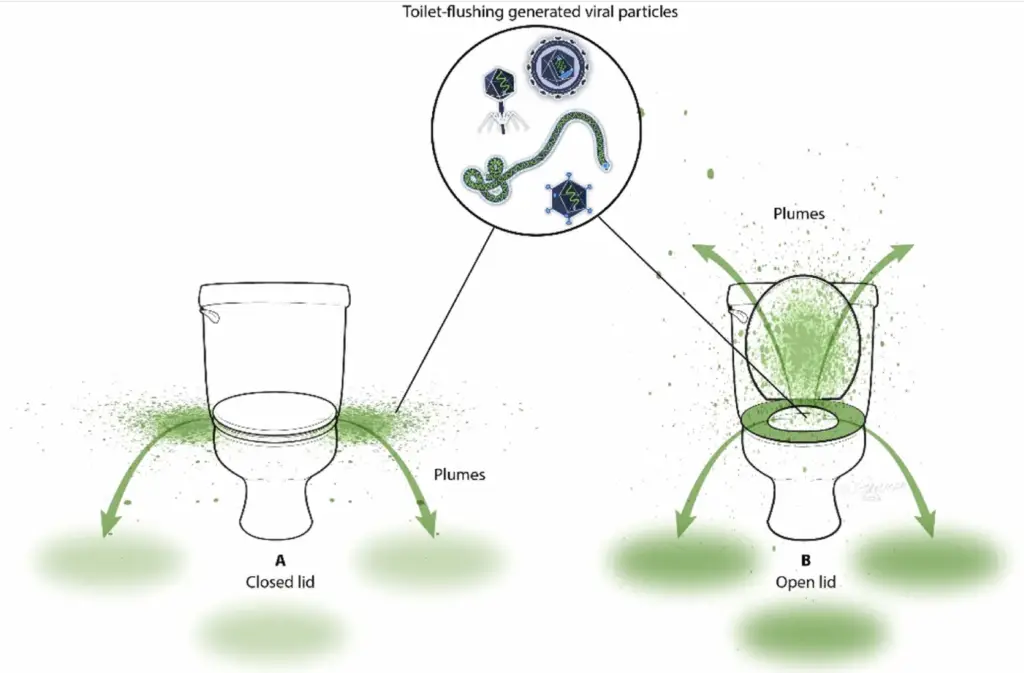In a study conducted by scientists from the Department of Environmental Science at the University of Arizona and researchers from Global Research and Development for Lysol and Dettol, a subsidiary of Reckitt Benckiser LLC, the impact of toilet flushing on viral contamination of surfaces in restrooms has been brought to light.
The study, titled “Impacts of lid closure during toilet flushing and of toilet bowl cleaning on viral contamination of surfaces in United States restrooms,” delves into the often-overlooked issue of viral aerosols generated during toilet flushing, which can potentially serve as a route of pathogen transmission.
One of the key highlights of the study is the use of bacteriophage MS2 as a surrogate for human enteric viruses. Bacteriophages are viruses that infect bacteria and are harmless to humans. This choice of surrogate is crucial as it allows researchers to simulate the behavior of pathogenic viruses without posing any risk to human health. By utilizing bacteriophage MS2, scientists could accurately assess the spread of viruses in restroom environments without the ethical or safety concerns associated with using actual pathogens.
The findings of the study challenge common assumptions about toilet lid closure prior to flushing. Contrary to popular belief, the research reveals that closing the toilet lid does not mitigate the risk of contaminating bathroom surfaces with viral aerosols. Even with the lid closed, viral contamination of restroom surfaces remained prevalent after flushing.

Moreover, the study emphasises the importance of proper toilet bowl cleaning practices in reducing viral contamination. When toilet bowls were cleaned using a bowl brush with a commercial disinfectant, a significant reduction in viral contamination was observed. This highlights the effectiveness of disinfection in preventing the spread of viruses in restroom settings.
This research highlights the need for comprehensive strategies to mitigate the spread of viruses in public restrooms. Simply closing the toilet lid is not enough to prevent viral contamination, and proper disinfection practices are essential.
The implications of this research extend beyond restroom hygiene. With the ongoing concerns surrounding infectious diseases, understanding the dynamics of viral transmission in everyday environments is crucial for public health efforts. By shedding light on the role of toilet flushing in spreading pathogens, this study paves the way for more effective strategies to mitigate the risk of viral transmission in communal spaces.
As the world grapples with the challenges posed by infectious diseases, studies like this serve as a reminder of the importance of rigorous scientific research in safeguarding public health. With further investigation and implementation of evidence-based practices, we can work towards creating safer and healthier environments for all.
Have you liked what you have just read, click here to read more related content (phage-related news) like this one and also join our community by following the phage on X(formally Twitter), Facebook, and LinkedIn page
For more information about this study Goforth, M. P., Boone, S. A., Clark, J., Valenzuela, P. B., McKinney, J., Ijaz, M. K., & Gerba, C. P. (2024). Impacts of lid closure during toilet flushing and of toilet bowl cleaning on viral contamination of surfaces in United States restrooms. American Journal of Infection Control. https://doi.org/10.1016/j.ajic.2023.11.020
Note: This research collaboration included a private company specializing in the production of disinfectants.




Comments